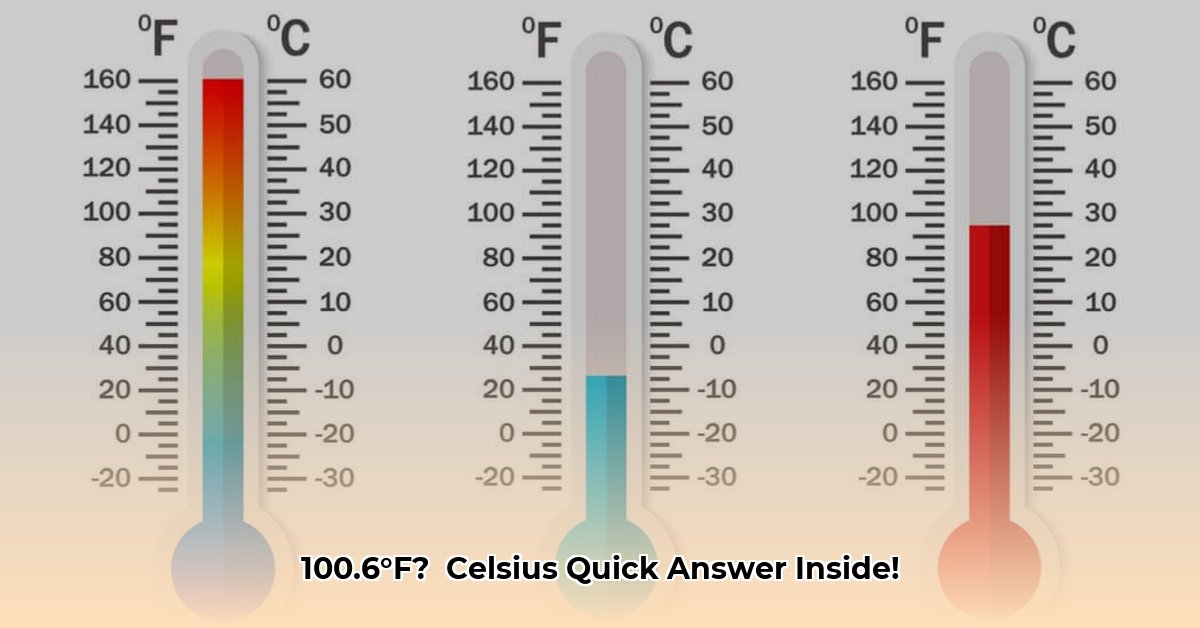This guide provides a quick conversion of 100.6°F to Celsius, along with helpful context and information about temperature scales.
Quick Conversion and Understanding the Basics
Fahrenheit and Celsius are simply different scales for measuring temperature. 100.6°F is equivalent to 38.11°C. While Fahrenheit is commonly used in the United States, Celsius is the standard in most other parts of the world.
Conversion Formula and Calculation
The formula to convert Fahrenheit to Celsius is: °C = (5/9) * (°F – 32).
Here’s how to convert 100.6°F:
- Subtract 32: 100.6 – 32 = 68.6
- Multiply by 5: 68.6 * 5 = 343
- Divide by 9: 343 / 9 = 38.11
Therefore, 100.6°F is approximately 38.11°C.
Nearby Temperature Conversions
Here’s a comparison of temperatures near 100.6°F:
| Fahrenheit (°F) | Celsius (°C) |
|---|---|
| 100°F | 37.78°C |
| 100.5°F | 38.06°C |
| 100.6°F | 38.11°C |
| 101°F | 38.33°C |
| 102°F | 38.89°C |
Understanding 38.11°C: Context and Significance
A temperature of 38.11°C is considered a low-grade fever in adults. Normal body temperature is around 37°C (98.6°F). While a slight increase can be caused by factors like exercise or a warm environment, 38.11°C accompanied by chills, aches, or fatigue may suggest an infection.
Fevers in Children: Important Considerations
Children, especially infants, are more susceptible to the effects of fever due to their developing immune systems. Here’s a general guideline, though consulting a pediatrician is always recommended:
| Age Group | Temperature Indicating Need for Doctor’s Attention |
|---|---|
| Newborns (0-3 months) | 38.0°C (100.4°F) or higher, requires immediate attention |
| Infants (3-6 months) | 38.3°C (101.0°F) or higher |
| Children (6 months – 2 years) | 39.4°C (103.0°F) or higher |
Managing Fevers: Practical Advice
For low-grade fevers, rest and hydration are crucial. Over-the-counter medications like acetaminophen or ibuprofen can help reduce fever and discomfort. However, it’s essential to follow dosage guidelines and avoid giving aspirin to children. Consult a doctor if the fever persists for more than three days, worsens, or is accompanied by other concerning symptoms.
Beyond Fevers: Other Applications of 38.1°C
While often associated with fever, 38.1°C can be relevant in other areas, such as:
- Industrial Processes: Precise temperature control is critical in many industrial settings. 38.1°C might be a required temperature for specific reactions or procedures.
- Scientific Experiments: Research often requires maintaining specific temperatures for observations and analysis, and 38.1°C could be a target temperature.
- Culinary Arts: While less common, temperature control is important in certain culinary processes like slow cooking or proofing yeast. Although 38.1°C may not be a standard cooking temperature, it could have niche applications.
The Evolving Science of Temperature
Our understanding of temperature and its effects is continuously evolving. Current research explores various aspects of temperature measurement, from the nanoscale to large-scale climate studies. While the basic Fahrenheit to Celsius conversion remains unchanged, the interpretation and application of temperature data are subject to ongoing research and refinement. It is important to stay informed about current medical and scientific understanding and consult with professionals when necessary.
- The Best Bento Box Price For Your Perfect Packed Lunch - December 15, 2025
- Bento Box Shopping Tips for Smart and Stylish Lunch Prep - December 14, 2025
- Bento Box Trays Streamline Restaurant Meal Presentation and Transport - December 13, 2025










